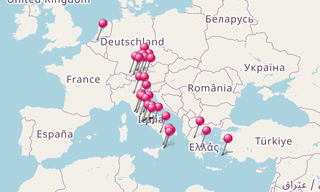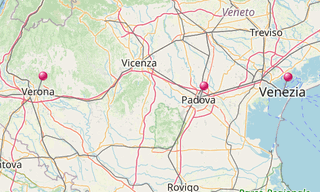Verona is a city in Veneto, northern Italy. The city has been awarded World Heritage Site status by UNESCO because of its urban structure and architecture. The play Romeo and Juliet written by William Shakespeare was based in Verona.
Main sights
- Verona is famous for its Roman amphitheatre, the Arena, completed around 30 AD, which is the third largest in Italy, after Rome’s Colosseum and the arena at Capua. It measures 139 m long and 110 m wide, and could seat some 25,000 spectators in its 44 tiers of marble seats. The ludi (shows and gladiator games) performed within its walls were so famous that they attracted spectators from far beyond the city. The current two-story façade is actually the internal support for the tiers; only a fragment of the original outer perimeter wall in white and pink limestone from Valpolicella, with three stories remains. The interior is very impressive and is virtually intact, and has remained in use even today for public events, fairs, theatre and open-aired opera during warm summer nights.
- The Basilica of San Zeno Maggiore is considered one of the great achievements of Romanesque architecture. The present structure is the 3rd on this site, built from 1123 - 1135, over the 4th century shrine to Verona’s patron saint, St Zeno (died 380). The façade dominates the large square, and is flanked with a beautiful 72 m tall bell tower, which is mentioned by Dante in Canto 18 of Purgatory in the Divine Comedy. The lintels above the portal have carvings of the months of the year. The interior of the church is divided into a Lower Church, occupying about 2/3 of the structure, and the Upper Church, occupying the remainder. The walls are covered with 12th and 14th century frescos and the ceiling of the nave is a magnificent example of a ship’s keel ceiling. The vaulted crypt contains the tomb of St Zeno, the first Bishop of Verona, as well as the tombs of several other saints. North of the church is a pleasant cloister. The church also houses the tomb of King Pippin of Italy (777 - 810).
- The small Romanesque Basilica of San Lorenzo is one of the finest and most important in the city. Its dates from around 1177, but is built on the site of a Paleochristian church, some fragments of which remain. The church is built of alternating tracks of brick and stone, and has two cylindrical towers, housing spiral staircases to the women’s galleries. Inside, the atmosphere is rather severe, but is still quiet and peaceful. The striped bands of stone and brick and the graceful arches complement the setting.
- With a span length of 48.70 m, the 1356 completed segmental arch bridge Ponte Scaligero featured at the time the world’s largest bridge arch.
- Santa Maria Antica is a huge Romanesque church. It was the parish church of the Scaligeri clan, and is famous for the Gothic Scaliger Tombs.
- The Duomo is also a notable Romanesque church.
- Sant’Anastasia is a huge and lofty church built from 1290 - 1481 by the Dominicans to hold the massive congregations attracted by their rousing fundamentalist sermons. The Pellegrini chapel houses the famous fresco St George and the Princess of Trebizond by Pisanello as well as the grave of Wilhelm von Bibra.

-Basilica-di-San-Zeno.hero.landscape.jpg?w=1600)


-Basilica-di-San-Zeno.jpg?w=256)
-Basilica-di-San-Zeno.jpg?w=256)
-Basilica-di-San-Zeno.jpg?w=256)
-Basilica-di-San-Zeno.jpg?w=256)
.jpg?w=256)
-Duomo.jpg?w=256)
.jpg?w=256)
-Romeo-and-Juliet-Balcony.jpg?w=256)
-Basilica-di-San-Zeno.jpg?w=256)
-Basilica-di-San-Zeno.jpg?w=256)
-Sant%E2%80%99Anastasia.jpg?w=256)
-Basilica-di-San-Zeno.jpg?w=256)
-Basilica-di-San-Zeno.jpg?w=256)
-Basilica-di-San-Zeno.jpg?w=256)
-Basilica-di-San-Zeno.jpg?w=256)
-San-Giorgetto-dei-Domenicani.jpg?w=256)
-Basilica-di-San-Zeno.jpg?w=256)
-Basilica-di-San-Zeno.jpg?w=256)
.jpg?w=256)
-Basilica-di-San-Zeno.jpg?w=256)
-Duomo.jpg?w=256)
-Basilica-di-San-Zeno.jpg?w=256)
-Duomo.jpg?w=256)
-Basilica-di-San-Zeno.jpg?w=256)
-Sant%E2%80%99Anastasia.jpg?w=256)
-Arena.jpg?w=256)
.jpg?w=256)
-Basilica-di-San-Zeno.jpg?w=256)
-Basilica-di-San-Zeno.jpg?w=256)
-Duomo.jpg?w=256)
.jpg?w=256)
-Basilica-di-San-Zeno.jpg?w=256)
-Basilica-di-San-Zeno.jpg?w=256)
-Duomo.jpg?w=256)
-Arena.jpg?w=256)
.jpg?w=256)
-Basilica-di-San-Zeno.jpg?w=256)
-Basilica-di-San-Zeno.jpg?w=256)
-Basilica-di-San-Zeno.jpg?w=256)
-Basilica-di-San-Zeno.jpg?w=256)
-Duomo.jpg?w=256)
-Basilica-di-San-Zeno.jpg?w=256)
-Sant%E2%80%99Anastasia.jpg?w=256)
-Basilica-di-San-Zeno.jpg?w=256)
-Duomo.jpg?w=256)
-Basilica-di-San-Zeno.jpg?w=256)
-Basilica-di-San-Zeno.jpg?w=256)
-Basilica-di-San-Zeno.jpg?w=256)
-Basilica-di-San-Zeno.jpg?w=256)
-Basilica-di-San-Zeno.jpg?w=256)
-Basilica-di-San-Zeno.jpg?w=256)
-Duomo.jpg?w=256)
-Basilica-di-San-Zeno.jpg?w=256)
-Basilica-di-San-Zeno.jpg?w=256)
-Basilica-di-San-Zeno.jpg?w=256)
-Basilica-di-San-Zeno.jpg?w=256)
-Duomo.jpg?w=256)
-Basilica-di-San-Zeno.jpg?w=256)
-Basilica-di-San-Zeno.jpg?w=256)
-Basilica-di-San-Zeno.jpg?w=256)
.hero.jpg?w=320)

.hero.jpg?w=320)

.hero.jpg?w=320)

.hero.jpg?w=320)
.map.png)